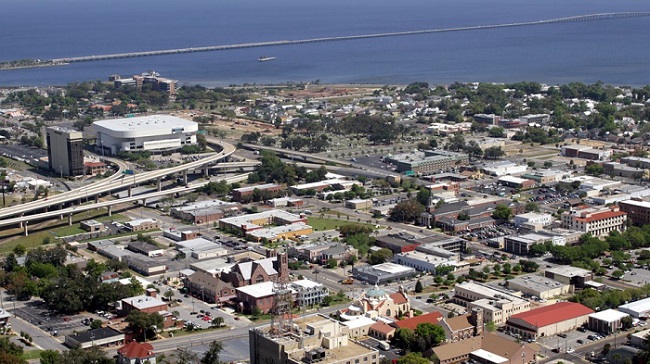New index shows Northwest Florida trails nation in skilled, educated workers
- February 13, 2015
- / Jeffrey Cassady
- / economy

Northwest Florida’s warm weather and low-tax environment might make it a pleasant place to live, but communities here are struggling to attract and retain skilled workers.
Recent research by the University of West Florida Haas Center found that the Pensacola and Panama City areas have a harder time attracting and keeping skilled workers than do other metro areas around the country. However, Okaloosa County – defined as the Crestview-Fort Walton Beach-Destin metropolitan statistical area – does a slightly better job than the country as a whole at offering quality jobs to skilled laborers.
“Maintaining high average wages is an increasing challenge for Florida,” said UWF economist Rick Harper, who serves as director of the Studer Institute and oversees the University’s Office of Economic Development and Engagement. “Some of our fastest business growth has been in meeting the needs of tourist and retiree customers, and these sectors tend to have lower-than-average wages. That doesn’t create the labor force that will draw high-tech, high-wage businesses to the state. We have a pressing need to build skill sets that will earn enough to support families.”
College-educated and other skilled workers generally earn more than their low-skill counterparts. In addition, they tend to raise incomes in the areas in which they reside by creating jobs and convincing firms that employ skilled workers to relocate or expand in the region.
A dearth of jobs requiring a college education or special skill set can create a situation in which skilled workers who want to stay in an area must accept lower pay or take positions that aren’t commensurate with their skill level. Faced with that kind of choice, such workers might choose to migrate to areas that provide better jobs and a larger professional community.
“This is one thing that can affect migration of skilled workers to a region,” said Soheil Nadimi, the Haas Center economist who conducted the analysis.
The Haas Center’s findings are presented in its new Jobs Skills Index. Over the past few months, Nadimi analyzed May 2009-May 2011 wage data by occupation for Florida’s 22 metro areas and 347 metro areas around the country, with the exception of Washington D.C.
“In areas that rank highly on the skills index, educated workers would be part of a cluster of skilled workers where it is more likely that they could develop professionally,” Nadimi said.
The Haas Center study controlled for factors that could skew a metro area’s index score. Those factors included differences in the price of goods and services from area to area, sudden shocks to labor supply or demand and the presence of regional amenities, such as universities and state facilities.
“A specific occupation can raise an area’s Job Skills Index score if it requires higher-than-average skill levels and the share of the occupation in that area is higher than the national average, or if it requires lower-than-average skills but the area’s share of the occupation is lower than the national average,” Nadimi said.
Okaloosa County placed ninth in the index with a score of 1.3, above the national metro area average, which was set to zero.
The Pensacola area, which includes neighboring Santa Rosa County, ranked 11th on the list with a score of -0.9, while Panama City came in 15th, generating an index score of -4.4. Both clocked in below the national average.
Tallahassee topped the list of Florida metro areas with a score of 8.6. Meanwhile, the Palm Coast area, which is just south of St. Augustine on the state’s Atlantic coast, ranked lowest among Florida’s 22 metros with a score of -9.3
The west-of-Tallahassee metro areas did better when compared to their counterparts around the state. Florida’s 22 metro areas had an average index score of -1.
The Crestview-Fort Walton Beach-Destin metro area scored 2.3 points better than the state average, while the Pensacola area notched just 0.1 points above the state average.
The Panama City area trailed the rest of Northwest Florida at 3.4 points below the state average.
Below are the complete rankings with each metro area’s index score:
- Tallahassee, 8.6
- Palm Bay-Melbourne-Titusville, 7.9
- Gainesville, 4.9
- Tampa-St. Petersburg-Clearwater, 4.4
- Jacksonville, 3.3
- West Palm Beach-Boca Raton-Boynton Beach, 2.3
- Fort Lauderdale-Pompano Beach-Deerfield Beach, 2.2
- Miami-Miami Beach-Kendall, 1.6
- Crestview-Fort Walton Beach-Destin, 1.3 National average, zero
- Orlando-Kissimmee-Sanford, -0.3
- Pensacola-Ferry Pass-Brent, -0.9 State average, -1
- Lakeland-Winter Haven, -1.5
- Bradenton-Sarasota-Venice, -2.6
- Cape Coral-Fort Myers, -4.3
- Panama City-Lynn Haven-Panama City Beach, -4.4
- Port St. Lucie, -4.6
- Ocala, -4.7
- Deltona-Daytona Beach-Ormond Beach, -4.9
- Naples-Marco Island, -6.4
- Sebastian-Vero Beach, -6.5
- Punta Gorda, -8.6
- Palm Coast, -9.3
 CivicCon launches with a look at good growth in cities
CivicCon launches with a look at good growth in cities
 Building stronger brains one baby, one parent at a time
Building stronger brains one baby, one parent at a time
 SCI debuts commercial on Early Learning City
SCI debuts commercial on Early Learning City
 Entrecon: World class speakers and an opportunity to sharpen skills
Entrecon: World class speakers and an opportunity to sharpen skills
 PYP Quality of Life survey 2017
PYP Quality of Life survey 2017
 EntreCon Pensacola 2016: A look back
EntreCon Pensacola 2016: A look back
 Leadership tip: getting better employee takeaways
Leadership tip: getting better employee takeaways
 Leadership tip: be interested instead of interesting
Leadership tip: be interested instead of interesting
 Leadership tip: delivering difficult messages
Leadership tip: delivering difficult messages
 Brain Bags boost Arc, Early Childhood Court programs
Brain Bags boost Arc, Early Childhood Court programs